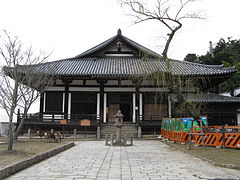Hokke-dō (Tōdai-ji)
Hokke-dō ( Japanese 法 華堂 ), also called "March Hall" ( 三月 堂 Sangatsudō ), is an old place of prayer in Nara that belongs to the Tōdai-ji . It is known for its prayer room, in which an extensive group of saints is set up, the oldest figures of which date from the Tempyō period (8th century).
Overview
The construction is estimated to be between 740 and 759. The Hokke-dō is the oldest building of Todaiji temple complex and as a National Treasure registered and part of the UNESCO - World Heritage Site . Because of its main character, the Fukūkenshaku Kannon, the small hall was also called Kenshakudō, but since the Hokkekai is held there every year on March 16 of the lunar calendar, it was given its current name.
The building consists of a rear building and the front prayer hall. Originally it was a double hall, but the prayer hall was rebuilt in 1199 under Priest Chōgen (1121-1206). Originally the group of figures consisted of eight figures, to which eight more were added over time.
Group of saints
The individual figures
( ⦿ = national treasure , ◎ = important cultural asset of Japan )
| No. | Name German | Japanese name | Dimensions [cm] |
material | period | comment |
|---|---|---|---|---|---|---|
| 1 | ⦿ Fukūkenshaku Kannon | 不 空 羂 索 観 音 | 362 | Dry paint | Tempyō | Main character ( 本尊 ) |
| 2 | ⦿ Bon-th | 梵天 | 402 | dito | dito | |
| 3 | ⦿ Taishaku-ten | 帝 釈 天 | 403 | dito | dito | |
| 4th | ⦿ Congo rikishi | 金剛 力士 | 306 | dito | dito | with closed mouth ( 吽 形 ) |
| 5 | ⦿ Congo rikishi | 金剛 力士 | 326 | dito | dito | with open mouth ( 阿 形 ) |
| 6th | ⦿ Jikoku-ten | 持 国 天 | 309 | dito | dito | One of the four kings of the sky |
| 7th | ⦿ Zōchō-th | 増 長 天 | 300 | dito | dito | One of the four kings of the sky |
| 8th | ⦿ Kōmoku-ten | 広 目 天 | 304 | dito | dito | One of the four kings of the sky |
| 9 | ⦿ Tamon-ten | 多 聞 天 | 310 | dito | dito | One of the four kings of the sky |
| 10 | ⦿ Shukongō-jin | 執 金剛 神 | 170 | dito | dito | |
| 11 | ⦿ Nikko-bosatsu | 日光 菩薩 | 207 | dito | dito | Guy not sure |
| 12 | ⦿ Gekkō-bosatsu | 月光 菩薩 | 204 | dito | dito | Guy not sure |
| 13 | ◎ Kichijō-ten | 吉祥 天 | 202 | dito | dito | |
| 14th | ◎ Benzai-th | 弁 財 天 | 219 | dito | dito | |
| 15th | ◎ Jizō-bosatsu | 地 蔵 菩薩 | 84 | Wood | Kamakura | |
| 16 | ◎ Fudō-myōō | 不 動 明王 | 86 | Wood | Muromachi |
Explanations of the figures
- Fukūkenshaku Kannon , in Sanskrit Amoghapāśa , has three eyes and eight hands ( 三 目 八 臂 , sammoku happi ). One attribute is the snare ( 羂 索 ) in one hand. The Kannon wears a silver crown with precious stones and has a deer skin ( 鹿皮 , shikagawa ) over the shoulder. It is therefore also called Shikagawa Kannon .
- Bon-ten and Taishaku-ten belong to the group of the sky lords.
- The two Kongō-rikishi , also called Niō, are often paired guards in temple gates.
- The four kings of heaven protect the altar in the four directions. In order not to cover up the central cult figure or to be covered by it, Jikoku-ten (attribute: sword) is in the southeast, Zōchō-ten (attribute: lance) in the southwest, Kōmoku-ten (attribute: scroll and brush) in the northwest , Tamon-ten (attribute: small treasure pyramid) in the northeast.
- Shukongō-jin wears armor and a lance in defense of Buddhism. It is similar to the Kongō-rikishi or the Niō.
- Nikkō-bosatsu (sunlit) and Gekkō-bosatsu (moonlight) are two bodhisattva who usually flank a central figure. They usually hold a lotus flower in their hands and their head is typically turned slightly outwards. These attributes are missing here, so the assignment is not certain.
- Kichijō-ten and Benzai-ten are two female deities.
- Jizō- bosatsu is the protector of hikers and children.
- Fudō-myōō is one of the sky gods. He is often depicted with a chain and in his hands in front of a flame background
Image selection
Web links
literature
- Leaflet of the Hokkedō.
- N. Nozawa (Ed.): Nara-ken no rekishi sampo (jo). Yamakawa Shuppan, 2010, ISBN 978-4-634-24629-4 .
- Takeshi Hisano: Butsuzō junrei jiten. Yamakawa shuppa, 1986, ISBN 4-634-60180-X .
Coordinates: 34 ° 41 ′ 19.5 ″ N , 135 ° 50 ′ 38.5 ″ E







